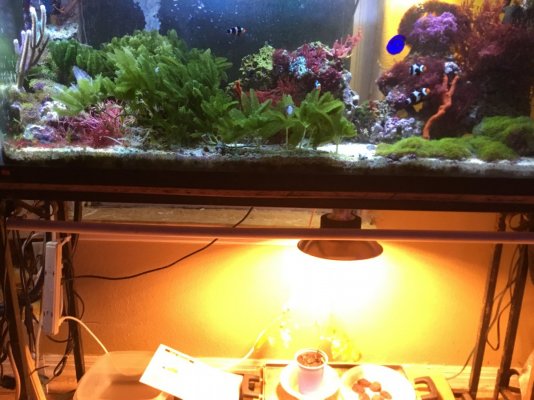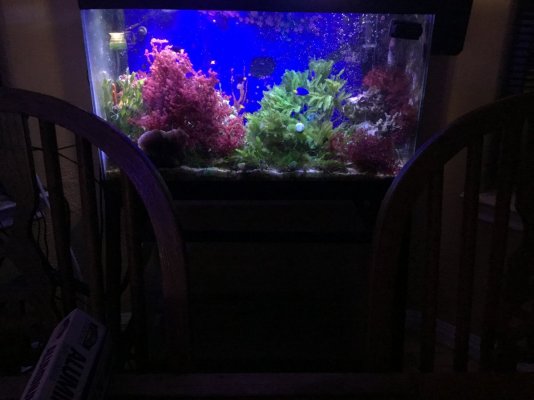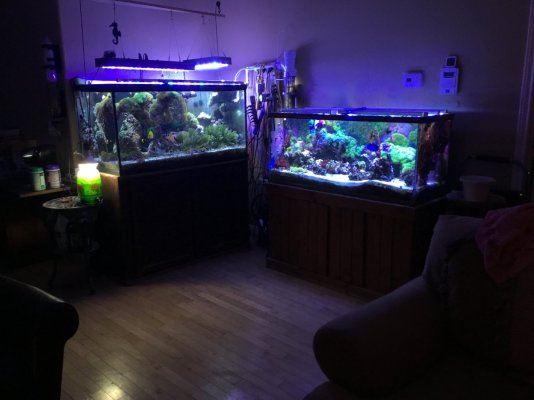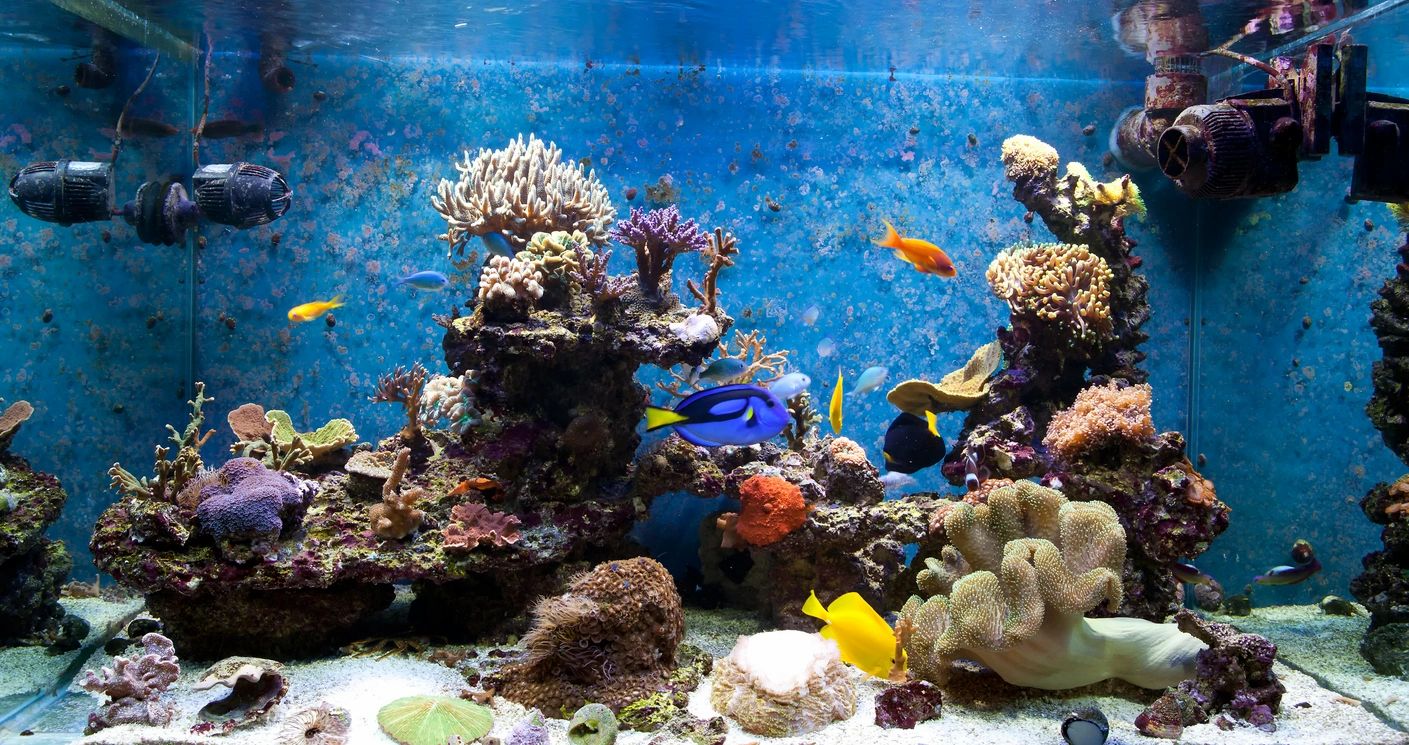- Joined
- Aug 12, 2018
- Messages
- 252
- Reaction score
- 387
I have something similar from the live rock I got from Tampa Bay Live Rock last year. Based on my research, thus is what I determined it was.Lights just came on and I found this guy.
Follow along with the video below to see how to install our site as a web app on your home screen.
Note: This feature may not be available in some browsers.
I have something similar from the live rock I got from Tampa Bay Live Rock last year. Based on my research, thus is what I determined it was.Lights just came on and I found this guy.
Howdy, Esox and welcome.... most successful ug hobbyist vacuum the substrate to remove larger particles of waste to keep them from breaking down.
Glad I found this thread! Been planning on going back to UGF after having given the "new" methods a spin, but was starting to have serious doubts.
Set up my first saltwater tank--a 2nd-hand 29 gallon--when I was a teen back in the '80s. Had 3" of crushed coral over an UGF powered by an ancient little air pump that pushed out less air than a hyperventilating cricket. Ran that tank successfully and continuously for about five years or so. With precious little stocking guidance back then, I only had two losses. More importantly, nitrates were never an issue, and what little algae grew was easily scrubbed off the glass and plastic decor. I stuffed those fish with food.
Fast forward to about six years ago, I set up 56 gallon tank. I was amazed at the changes in the hobby over the decades and was determined to do it right: sump, RO water, LED lighting on a strict schedule, shallow sand bed, live rock, protein skimmer, limited feedings, cleanup crew, light bio load, etc. Ended up waging a multi-year battle with nitrates and hair and bubble algae until my wife's essential oil diffuser wiped out everything but a clownfish. Truth be told, I was ready to wave the white flag by then anyway. That was a couple years ago.
Now I'm getting ready to set that tank up again, but I'm going back to the UGF. Got the filter plates and enough crushed coral for a 4" bed. Was going to try Kevin Novak's slow-moving plenum method, but after seeing and reading about Subsea's and Paul B's tanks, I think I'm going to go with reverse flow. Thinking of powering it with the return line of a canister filter. Also planning to add some AIO chambers for surface skimming, the heaters, and now maybe a cryptic zone. Will build a floating reef off the outside of the AIO chambers to limit structure on the substrate.
Still got that clownfish. Mean little bugger. Spends his days in an EVO 13 eagerly waiting for new opportunities to ambush my hand. I swear he's learned that biting between the fingers causes more pain. Gotta love him, tho!



Sub, my Buddy. I bet you could emphasize enough if you tried.I can not emphasize enough the importance of biodiversity in diver collected live sand and live rock.
 gulfliverock.com
gulfliverock.com
I agree with at @Paul B and @Subsea on all of it. Diversity helps so much. I believe it is the main reason I can keep, even the hardest to keep, nems alive. Nothing like giving the critters as close to home as you can.@Esox,
Ask @Paul B where he collects his critters: grass shrimp in the marshes and amphipods under th3 hubcaps in the mud of Long Island Sound.
My first marine tank was critters collected from the jetties in Galveston, while I attended Texas Maritime Academy. Now I live 3 hours north of Corpus Christi so I get my biodiversity from Florida collectors.
Premium Decorative Live Rock is our most popular rock. This rock will have thick coralline algae on it and a mixed variety of plants, animals, hard and soft corals, sponges and so much more. This type of rock has an enormous variety of animal and encrusting marine life. The shapes and sizes are extremely unique. This rock could contain multi-colored Christmas tree worms, cup and tube corals, feather dusters, gorgonians, serpulid worms and encrusting clams.
Gulf Live Rock.com
gulfliverock.com
This rock is fully blanketed with colorful coralline algae's, these algae's come in multitudes of fascinating shades of purple, reds, oranges, peaches and yellows. Most rocks contain bryzoans,orange leather sponge,gracilaria algae,halimeda, sea grapes, cluster corals, and cup corals. All of our premium decorative live rocks contain seeded plant life,both macro and micro algae.All pieces are hand collected fresh from our gulf lease site by our diving staff and shipped directly to our customers.We do not use any chemicals in our process. The rocks pictured are for example only. All of our premium decorative live rock is as good or better than the rocks pictured. This is Florida Aquacultured live rock.
All of our live rock comes from our personal Federal Aquaculture Lease site located 10 miles offshore in the Gulf of Mexico. All of our rock was planted on the ocean floor in 1994. So you can image how much marine life has grown on it in over the last 15 years. We have live rock in all different sizes and we can custom fit your order. Our premium decorative live rock starts at $5 a pound. We offer wholesale prices on larger volume orders.
I agree with at @Paul B and @Subsea on all of it. Diversity helps so much. I believe it is the main reason I can keep, even the hardest to keep, nems alive. Nothing like giving the critters as close to home as you can.
I will add one more to the list. If just looking for some diversity.
: : : : Indo-Pacific Sea Farms : : : :
Indo-Pacific Sea Farms produces captive-bred marine life for healthier reef aquariums: invertebrates, detritivores, live sand, snail grazers, amphipods, beneficial worms, macro algae, plankton, corals, coral food and beneficial bacteria.www.ipsf.com
They have critter packs.
Anohter thing to look into is live sand from the gulf. You can get it from a few vendors that pull it from lease sites in FL. It is more coarse and contains lots of critters. If you are ordering live rock from one, you may as well get some live sand.
That he is. In short "One Heck of a Guy" lol.IndoPacificSeaFarm is my inspiration for algae filtration and people edible algae, Gracilaria Parvispora is Tang Heaven Red for herbivore fish and it is a staple for Hawaiian as the original Red Ogo.
on a personal note about the owner of IPSF, Gerald Hesslinger passed on a pHD opportunity at Harvard to establish clam farming with native villages on remote Pacific Islands. He partnered with several other environmental stewards to elevate people from poverty. Gerald is a great humanitarian, whom I have only meet once in person.
That he is. In short "One Heck of a Guy" lol.
I have that in honor of my Grandfather. He had a sleeve of a little dachshund wearing a pickelhaube being chased by Chesty. 3rd generation Corp (retired) here, so appreciate you recognizing my sig lol.As you may guess, I am all about veterans. I noticed your signature:
According to legend, the Marines at Belleau Woodwere called “Teufelshunde” or “Devil Dogs” by their German opponents. The nickname endures today as part of the Marine Corps' legacy.
I say, “Seize the Day”.
Semper fi, Leatherneck. Spent a little time in the Corps, myself, back in the '90s.3rd generation Corp (retired) here, so appreciate you recognizing my sig lol.
Anohter thing to look into is live sand from the gulf. You can get it from a few vendors that pull it from lease sites in FL. It is more coarse and contains lots of critters.
I would caution against too deep of a sandbed because of the higher demand for sandbed maintenance.
Ok, @Essox I blame you..... I'm going to redo my 20 long. Dump the sump. Use a modified Aqua-clear refugium, to move water from a UG filter. Current setup on this system never really worked , time for a change.
@Essox
I feel that 2”-3” is an ideal depth. No need to seperate differrent substrates. For my false bottom, I used light diffuser plate (egg-crate) and covered with window screen material from Home Depot ( nylon or fiberglass) are common materials.
